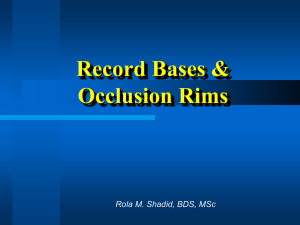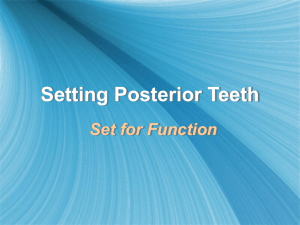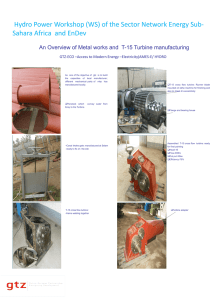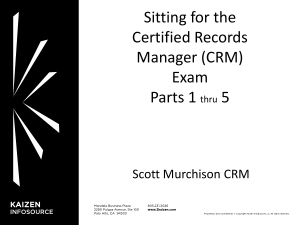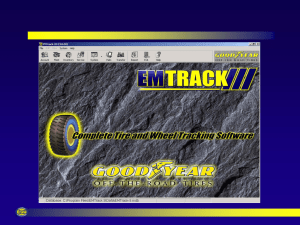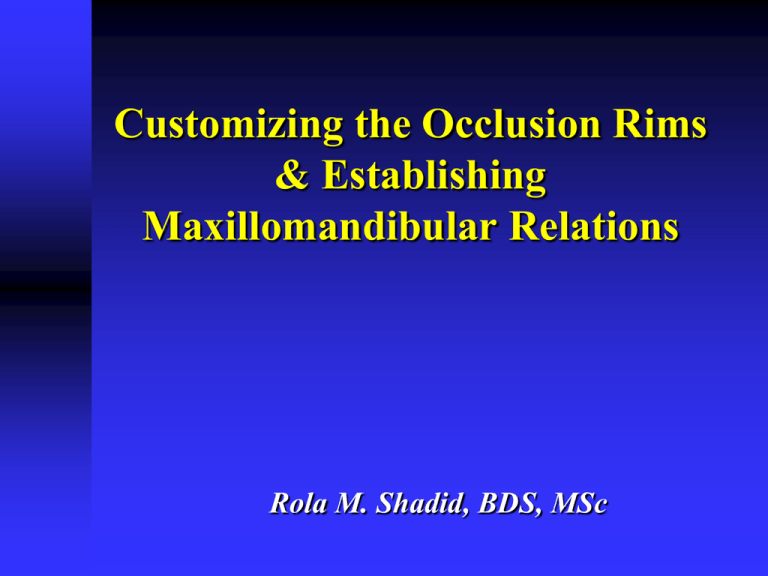
Customizing the Occlusion Rims
& Establishing
Maxillomandibular Relations
Rola M. Shadid, BDS, MSc
Procedures Carried Out During Jaw
Relation Appointment
Establishing the labial form of rims
Establishing the occlusal plane
Establishing vertical jaw relation
Establishing & recording of centric jaw
relation
Facebow transfer (will be discussed in
lab.)
Selection of artificial teeth
Record Base Stability & Retention
Required for record making and
phonetic tests
Ensure that the rim is well adapted
Alternating finger pressure on both
sides of each rim should not elicit
rocking
Inaccurate if loose
Use denture adhesive if slightly loose
Pronounced looseness - REMAKE
Record Base Retention
Causes of Poor Retention
Poor adaptation of resin to cast
(particularly from the posterior border
and palate) during polymerization.
Over- or under-extension
Excessive block-out
Establishing The Labial Form Of
Maxillary Occlusion Rim
Aimed at establishing the anteroposterior position of
the anterior teeth & the esthetics of the lips & face
The operator uses the following guides:
1. Facial esthetics
2. Phonetic guidelines *
3. Incisive papilla guide: On average, the facial surface
of the central incisors should be approximately 8-10
mm anterior to a line drawn perpendicular to the
palatal midline, passing trough the distal aspect of the
incisive papilla
Establishing The Labial Form Of Maxillary
Occlusion Rim Using “Facial Esthetics”
Facial esthetics as a guide:
1. Fullness of the upper lip
2. The philtrum
3. The nasolabial fold
4. Commissures of the mouth*
Establishing The Labial Form Of
Maxillary Occlusion Rim Using
“Facial Esthetics”
Lips should be unstrained
• Naso-labial angle ≈ 90°
• Philtrum depressed
• Vermilion border *
showing
The Buccal Corridor *
Excessive buccal corridor results
in dark space which appear
unesthetic
Inadequate buccal corridor
Establishing Level & Inclination of
Occlusal Plane *
Establishing occlusal plane using the
maxillary occclusion rim
Establishing occlusal plane using the
mandibular occclusion rim
Establishing Occlusal Plane Using the
Maxillary Occclusion Rim
The anterior height & inclination of the
upper occlusion rim
1. Incisal visibility
2. Interpupillary line
The posterior height & inclination of the
upper occlusion rim
1. Ala-tragus line (Camper’s line) ¤
2. Stensen’s duct
Maxillary Occlusion Rim
Adjustment
Anterior
height 1-2 mm
below the lip
at rest/when
the patient
slightly smiles
Maxillary Occlusion Rim
Adjustment
Touches wet
line of lower
lip when ‘F’ or
‘V’ sounds
Count ‘50-60’
Wax rim/tooth display can be
adjusted with sex, age, and lip
(Journal of prosthetic dntistry 1978).
Lip Length Incisal Display
10-20mm
3-4mm
20-25mm
2mm
26-30mm
1mm
>30mm
0
Sex & Age
Female
Young +2
Middle +1
Old
0
Male
+1
0
-1
Maxillary Occlusion Rim
Adjustment
Mediolaterally the
anterior portion of
occlusal plane *
parallels the
interpupillary line
Fox plane can be
used
Maxillary Occlusion Rim
Adjustment
The anteriorposterior
orientation of
occlusal plane
parallel to the
ala-tragus line
(Camper’s line)
Maxillary Occlusion Rim
Adjustment
Stensen’s duct can be used as a guide, the
posterior occlusal plane is levelled at
about quarter inch below Stensen’s duct
Once the occlusal height of one of
occlusion rims is established, the vertical
height of opposing rim is adjusted to
provide for an interocclusal distance (ID)
of 2-4 mm. Then the lower rim is leveled
such that it meets the upper rim evenly
Establishing Occlusal Plane Using the
Mandibular Occclusion Rim
Anterior height
Posterior height
Mandibular Occlusion Rim
Adjustment
Anterior height
even with the
corners of the
mouth when
jaws are at rest
& the lip is
slightly parted
Mandibular Occlusion Rim
Adjustment
Posteriorly, the
occlusion rim
intersects 1/2 - 2/3 up
the retromolar pad *
Mandibular Occlusion Rim
Adjustment
1-2 mm
horizontal
overjet in
anterior &
posterior in
centric
position *
Mandibular Occlusion Rim
Adjustment
Unstrained lips
Vermilion
border showing
Once the occlusal height of one of
occlusion rims is established, the
vertical height of opposing rim is
adjusted to provide for an
interocclusal distance (ID) of 2-4
mm. Then the opposing rim is
leveled such that it meets the another
rim evenly
Establishing Jaw Relation
Vertical relation *
Horizontal relation
Establishing Occlusal Vertical
Dimension (OVD)
Methods* of Assessment of
OVD
1. Measuring the physiologic rest position
(PRP)
2. Feeling for interocclusal distance (ID) by
ensuring movement of mandible
3. Phonetics as a guide
4. Esthetics as a guide
5. Reference to previous dentures
6. Preextraction records
Methods of Assessment of
OVD
1. Measuring the PRP *
PRP = ID + OVD
Patient sitting bolt upright
PRP affected by posture
Measurements
OVD & PRP
Use external points for
ease of measurement
Small dots under
columella & midsymphisis
Use Boley Gauge, not
ruler
Measuring
Physiologic Rest Postion (PRP)
Open and close until lips barely touch
- Physiologic Rest Position (PRP)
Measure distance between dots
Measuring
Occlusal Vertical Dimension
Open and close until rims touch
Measure distance between dots (OVD)
Measurement will be different each
appointment
Measuring OVD
Measure the distance between
dots
At PRP
At OVD
Difference is ID
Measurements change each day
(position of dots)
Adjust the vertical height of other
rim ( will be the lower if you
established the vertical height of
upper) to provide for an
interocclusal distance (ID) of 2-4
mm. Then the lower rim is leveled
such that it meets the upper rim
evenly
Methods of Assessment of OVD
2. Feeling for Interocclusal Distance by
ensuring movement of mandible
Close until lips barely
touch - PRP
Place finger on chin
Look away
Patient closes until rims
touch (OVD)
Feel for movement of the
mandible
Methods of Assessment of OVD
3. Using Phonetics As A Guide
m sound: patient repeats the letter m and the distance
between two reference points are measured. The
occlusion rims adjusted so that they are 2 to 4 mm short
of this position when they are occluded
ch, sh, j, s, z sounds: at right vertical height there should
should not be more or less than 1 to 2 mm space between
upper & lower occlusion rims Closest speaking space *
Fricative sounds (f, v, ‘Fifty-Five’ , ask patient to count from
50 to 60) - upper incisal edges should JUST touch the
posterior one third of the lower lip
Methods of Assessment of OVD Using
4. Esthetics As A Guide
Assessment of facial proportion, expression
& esthetics.
If the face appears strained, the OVD may
be too much
If the corners of the mouth droop, making
chin appear too close to nose, the OVD
may be too less
Other Methods of Assessment of
OVD
5. Reference to previous dentures ¶
6. Preextraction records (e.g., articulated
casts £)
Establishing Occlusal Vertical
Dimension
Check with the first four
techniques to ensure acceptable
OVD
No one technique 100% correct
Wax Rim Adjustment at OVD
Flat even contact along
entire occlusal surface
EXTREMELY
CRITICAL
If uneven contact, patient
may be forced into
eccentric position
Eliminating Record Base or
Wax Rim Interferences
Patient in Centric
Position
Scribe three
widely separated
lines between
maxillary &
mandibular rims
Establishing OVD
Remove,
superimpose the
lines
Eliminate contacts
between record
bases, record
base/occlusion
rims
Refer to “Occlusal Vertical
Dimension” video
Effects Of Inadequate OVD
Decreased chewing efficiency
(fatigue when chewing)
Cheek biting
Collapsed Appearance - chin
too close to the nose
or protruding jaw, vermilion
border reduced to a line
Angular cheilitis
TMJ pain, TMJ clicking
Costen’s syndrome due to
prolonged overclosure
Effects Of Excessive OVD (Wax Rims
Too High)
Discomfort and annoyance to
patient
Trauma to underlying mucosa
(sore spots)
Sore muscles
Rapid bone resorption
Dentures click during speech
Rapid wear of acrylic teeth
Strained appearance
(elongated face)
Insufficient ID
Scribing Guide Lines on
Occlusion Rims *
Scribing Guide Lines on Occlusion
Rims (Midline)
Scribing midline:
nasal septum ,
philtrum, or labial
frenum as a guide
Ensure that these
guides coincide with
midline of face
Midline of Teeth = Facial
Midline
• Mark midline on the wax
Scribing Guide Lines on Occlusion
Rims (Canine Lines)
Corners of mouth at
rest coincide with
distal of canines
Or ala of nose
coincides with canine
cusp tip
To help in selection of
width of anterior teeth
Ala of nose
coincides with
canine cusp tip
Scribing Guide Lines on Occlusion
Rims (High Lip Line)
Scribing high lip
line
Ask patient to
smile & scribe a
line horizontally
marking the level
of exposure of
occlusion rim
during smiling
High Lip Line
Highest point of
upper lip when
smiling
Cervical necks lie at
or above this line
If shorter teeth are
selected, esthetics
compromised
Horizontal Jaw Relation
(Centric Relation Record)
Once OVD has been established, the
clinician proceeds to establish the
centric relation. It is classified as
horizontal relation because variations
from it occur in horizontal plane.
Centric Relation Record
Learned position
To obtain correct CR, you should train
the patient many times before
recording
Has some difficulties *
How To Obtain CR?
The Dawson method (bimanual manipulation)
produces reasonably good results (the method
of choice)
Giving instructions such as 'Close together slowly on
your back teeth‘
Ask the patient to curl the tongue to the back of the
mouth and to touch the posterior border of the upper
record block while closing
Protrude and retrude the mandible repeatedly, while
patient hold a finger lightly against chin
Swallow and close, disadvantage patient can swallow
to slight eccentric positions also.
The Dawson Method (Bimanual
Manipulation)
1. The patient should be placed in a slightly supine position
2. Put your index fingers on flanges of lower record block
to aid in stabilizing the record bases, and thumbs under
symphysis
3. Jiggle the lower jaw – the mandible should freely arc
4. Allow the patient to close the last portion
5. DO NOT PUSH THE MANDIBLE or dislodge the
record base
6. The registration media must be dead soft , when the
patient close into it
Procedure for Recording the
CR (watch the video)
1. Place two sharp ‘V’-shaped notches in
the wax in the premolar and molar areas
of the maxillary and mandibular rims (12 mm deep). Make sure there are no
undercuts in the rims or the ‘V’-shaped
notches
2. Place the record blocks intraorally and
guide patient into CR (by bimanual
manipulation) without recording media.
Train the patient several times before
taking the record
3. Place a thin layer of elastomeric
registration material over the entire arch
of the mandibular rim.
4. Stabilize the mandibular record base
using index fingers on the flange and the
thumbs under the symphysis
5. Ask the patient to open, relax, and slowly
close into CR
You should be able to gently arc the
mandible in a hinge like motion - without
translation of the mandible, without
much splinting
The patient slowly closes, and the
operator uses tactile input to ensure the
mandible does not move suddenly
forwards or to the side
6. The patient should close until the
occlusion rims are almost touching
(minimal closing pressure)
Ask the patient to stop as soon as this
position has been reached, or as soon as
they feel they are just barely touching the
rims together.
7. Never instruct the patient to bite
firmly - this can cause translation/
inaccuracy in the record.
8. Stabilize the patient’s mandible while the
material sets (never make a record
without keeping your hands in place - if
you feel movement during setting, redo
the record).
10. Reseat and
ensure the record
is repeatable.
Make sure the
record does not
capture the sides
of the occlusion
rims. *
11. Do NOT mount the casts unless you can get
full seating into the registration.
12. Place wax rims together, and lute them
together with sticky wax - 4 spots between the
wax rims
13. Immobilize your casts during mounting. If
you mount your casts without immobilizing
them, you can introduce occlusal discrepancy
14. Mix mounting plaster to creamy consistency
- place on cast and ring - close articulator
15. Smooth the mounting plaster
16. The occlusal rims should be touching
evenly, over the entire occlusal surface with
no contact of the maxillary and mandibular
casts or record bases. Only the occlusion rims
should be contacting.
What Type of Registration
Media to Use? *
Suitable materials include elastomeric bite
registration material , zinc oxide-eugenol
occlusal registration paste, quick setting
plaster, or bite registration wax.
Elastomeric materials produce more
accurate interocclusal records than wax.
Record the entire occlusal surface for
stability
References
1. Dalhousie Continual education
2. Complete Denture Prosthodontics, 1st
Edition, 2006 by John Joy Manappallil,
Chapter 9

